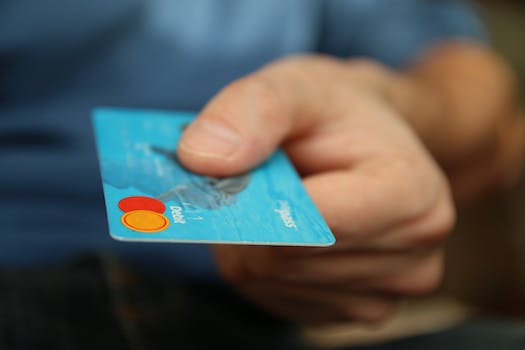-
Table of Contents
- Introduction
- Step One: Understand Your Credit Card Debt and Create a Plan
- Step Two: Prioritize Your Credit Card Debt and Make a Budget
- Step Three: Negotiate with Your Credit Card Company to Lower Your Interest Rates
- Step Four: Consider Debt Consolidation to Help Manage Your Credit Card Debt
- Step Five: Develop a Savings Plan to Achieve Financial Freedom
- Conclusion
“Take Control of Your Credit Card Debt and Unlock Financial Freedom!”
Introduction
Are you struggling with credit card debt? Do you feel like you’re never going to be able to get out of it? If so, you’re not alone. Credit card debt is a major problem for many people, but it doesn’t have to be. With the right steps, you can take control of your credit card debt and achieve financial freedom. In this article, we’ll discuss the steps you can take to get out of credit card debt and achieve financial freedom. We’ll cover topics such as budgeting, debt consolidation, and debt management. We’ll also discuss the importance of having a plan and staying motivated. By following these steps, you can take control of your credit card debt and achieve financial freedom.
Step One: Understand Your Credit Card Debt and Create a Plan

If you’re like many Americans, you may be struggling with credit card debt. It can be overwhelming and difficult to know where to start. But don’t worry, you’re not alone. With a few simple steps, you can get a handle on your debt and create a plan to pay it off.
The first step is to understand your credit card debt. Take a look at your credit card statements and make a list of all your credit card balances, interest rates, and minimum payments. This will give you a clear picture of how much you owe and how much you’re paying in interest each month.
Once you have a clear understanding of your debt, it’s time to create a plan. Start by setting a goal for how much you want to pay off each month. Then, prioritize your debts by interest rate. You should focus on paying off the debt with the highest interest rate first, while still making the minimum payments on all your other debts.
You may also want to consider consolidating your debt. This can help you save money on interest and make it easier to manage your payments.
Finally, make sure you’re budgeting for your debt payments each month. This will help you stay on track and ensure that you’re making progress towards your goal.
By taking the time to understand your credit card debt and create a plan, you can get a handle on your debt and start making progress towards becoming debt-free.
Step Two: Prioritize Your Credit Card Debt and Make a Budget
If you’re struggling with credit card debt, it’s important to prioritize your debt and create a budget to help you get back on track. Here are some tips to help you get started.
Prioritize Your Debt
The first step is to prioritize your debt. Start by making a list of all your credit cards and the amount of debt you owe on each one. Then, rank them in order of highest interest rate to lowest. This will help you determine which debt should be paid off first.
Create a Budget
Once you’ve prioritized your debt, it’s time to create a budget. Start by tracking your income and expenses for a month. This will help you identify areas where you can cut back and free up money to pay off your debt.
Once you’ve identified areas to cut back, create a budget that allocates money to each of your expenses, including your debt payments. Make sure to include a cushion for unexpected expenses.
Pay Off Your Debt
Now that you’ve prioritized your debt and created a budget, it’s time to start paying off your debt. Start by making the minimum payments on all your credit cards. Then, focus on paying off the card with the highest interest rate first. Once that card is paid off, move on to the next one.
By prioritizing your debt and creating a budget, you can get back on track and start paying off your credit card debt. It may take some time, but with dedication and discipline, you can become debt-free.
Step Three: Negotiate with Your Credit Card Company to Lower Your Interest Rates
Are you struggling to pay off your credit card debt? If so, you’re not alone. Many Americans are in the same boat. But there is hope. One way to reduce your debt burden is to negotiate with your credit card company to lower your interest rates.
It may seem intimidating to negotiate with a large financial institution, but it’s worth a try. Here are some tips to help you get started:
1. Do your research. Before you call your credit card company, take some time to research the current interest rates for similar cards. This will give you a better idea of what you should be asking for.
2. Be prepared. Have all of your financial information ready before you call. This includes your current balance, payment history, and any other relevant information.
3. Be polite. When you call, be polite and professional. Explain your situation and why you’re asking for a lower interest rate.
4. Make an offer. Once you’ve explained your situation, make an offer. Be reasonable and don’t be afraid to negotiate.
5. Follow up. If your offer is rejected, don’t give up. Follow up with the credit card company and see if they’re willing to negotiate further.
Negotiating with your credit card company can be a daunting task, but it’s worth a try. With a little bit of research and preparation, you may be able to lower your interest rates and reduce your debt burden. Good luck!
Step Four: Consider Debt Consolidation to Help Manage Your Credit Card Debt
Are you struggling to manage your credit card debt? If so, you’re not alone. Credit card debt is a major problem for many Americans, and it can be difficult to keep up with payments and interest rates. Fortunately, there are options available to help you manage your debt. One of these options is debt consolidation.
Debt consolidation is a process that involves taking out a loan to pay off multiple debts. This loan is typically taken out at a lower interest rate than the interest rates on your existing debts, which can help you save money in the long run. Additionally, debt consolidation can help simplify your debt payments by combining all of your debts into one monthly payment.
When considering debt consolidation, it’s important to make sure that you’re working with a reputable lender. Make sure to research the lender’s reputation and read reviews from other customers. Additionally, make sure to read the terms and conditions of the loan carefully before signing any documents.
Debt consolidation can be a great way to help manage your credit card debt. However, it’s important to make sure that you’re working with a reputable lender and that you understand the terms and conditions of the loan before signing any documents. With the right lender and loan terms, debt consolidation can be a great way to help you manage your credit card debt and save money in the long run.
Step Five: Develop a Savings Plan to Achieve Financial Freedom
Are you ready to take the next step towards financial freedom? Developing a savings plan is a great way to get started. Here are some tips to help you create a plan that works for you.
1. Set a Goal: Before you can start saving, you need to decide what you’re saving for. Are you saving for retirement, a down payment on a house, or a vacation? Once you have a goal in mind, you can start to create a plan to reach it.
2. Calculate Your Savings: Once you have a goal in mind, you need to figure out how much you need to save to reach it. Start by calculating how much money you need to save each month to reach your goal.
3. Automate Your Savings: Once you know how much you need to save each month, set up an automatic transfer from your checking account to your savings account. This will ensure that you are consistently saving each month and that you don’t forget.
4. Track Your Progress: It’s important to track your progress so that you can stay motivated and on track. Set up a spreadsheet or use a budgeting app to track your progress.
5. Make Adjustments: As you track your progress, you may need to make adjustments to your plan. If you find that you’re not able to save as much as you had planned, you may need to adjust your goal or find ways to cut back on expenses.
Creating a savings plan is the first step towards achieving financial freedom. With a little bit of planning and dedication, you can reach your goals and take control of your finances.
Conclusion
In conclusion, taking control of your credit card debt and achieving financial freedom is a process that requires dedication and hard work. It is important to create a budget, pay off your debt, and use credit responsibly. With the right strategies and a commitment to financial freedom, you can take control of your credit card debt and achieve financial freedom.















